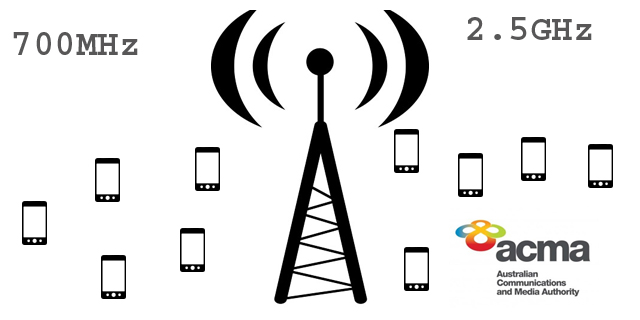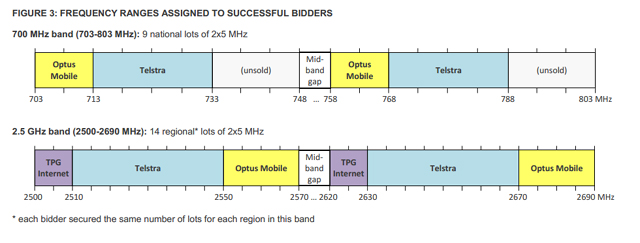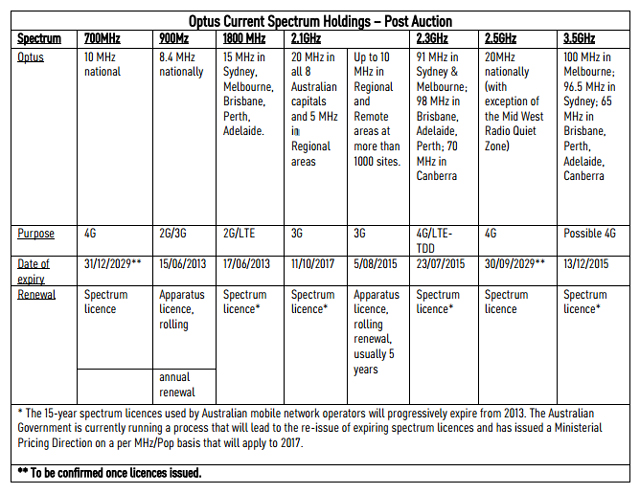
The Australian Communications and Media Authority (ACMA) yesterday announced the results of the auction for the 700 MHz and 2.5 GHz spectrum bands in Australia.
The auction began in May 2012, and ended up seeing Telstra and Optus vying for the coveted 700 MHz band as well as the 2.5 GHz which also went to surprise entrant, TPG.
The rules of the auction, which was conducted out of the public eye, stipulated that “a single bidder could not acquire more than 2 x 25 MHz (50 MHz in total) in the 700 MHz band and more than 2×40 MHz (80 MHz in total) in the 2.5 GHz band”.
$2b raised
Telstra spent up big – claiming almost the full amount of spectrum available – winning 2 x 20 MHz (40 MHz) of spectrum in the 700 MHz band, and 2 x 40MHz (80 MHz) in the 2.5 GHz band, costing the nation’s largest carrier a total of $1.3 Billion. Optus spent around half that – $650 Million – to secure 2 x 10 MHz (20 MHz) in the 700 MHz band, and 2 x 20 MHz (40MHz) in the 2.5 GHz range. Surprise entrant TPG spent $13.5 Million to secure 2 x 10MHz (20MHz) in the 2.5GHz band.
More notable than the names bidding for spectrum was the name missing – Vodafone previously stated they would participate in the 700 MHz auction, but could throw their hat in for 2.5 GHz – they appear to have pulled out entirely.
Nearly $2bn in total was raised from the auction, and ACMA advised there is still 2 x 15 MHz (30 MHz total) available in the 700 MHz band – however, all the allocated 2.5 GHz spectrum was allocated.
Allocation and Plans
The spectrum was allocated to bidders as follows:

The ACMA has advised that the licences for the 700 MHz band will commence on 1 January 2015. In most cases, licences for the 2.5 GHz band will commence on 1 October 2014 (except for the Metro Perth region and the Regional Western Australia region, which will commence on 1 February 2016).
Optus
Kevin Russell, Optus CEO, was quick to announce Optus’ intentions for their newly-purchased spectrum:
The spectrum Optus has acquired in the 700 MHz band will provide stronger 4G coverage across both metropolitan and regional Australia, allowing us to expand our 4G services to more customers than ever before
The additional spectrum purchased in the 2.5 GHz band, when combined with our already substantial holdings in 2.3 GHz, will enable Optus to provide unparalleled network capacity for 4G data services to our metropolitan customers.
Optus now owns spectrum across the board, however there are some issues with current technologies. Notably, Optus users in Canberra will not be able to access new 4G services locally on their current 4G smartphones, due to Optus not having a license to operate on this frequency in the area – they will instead begin rolling out the 2.3GHz frequency only.
With the completion of this auction, Optus’ Australian spectrum ownership now looks like this :

Telstra
The Telstra Exchange Blog was updated, with a statement from Telstra CEO David Thodey:
The spectrum will be used to enhance our network to help support extraordinary demand growth for mobile services and data. With the 700 MHz and 2.5 GHz spectrum we will be able to deliver faster speeds, more capacity and expansive wide area coverage of 4G LTE technology on our Next G® network.
The low-frequency nature of 700MHz means the mobile signal can travel relatively longer distances, which is ideal for improving the services we can offer to customers in rural and regional areas. It also means better in-building coverage in metro and suburban areas.
Telstra has also commented on the compatability of the 700MHz frequency for 4G LTE with other countries stating:
We expect much of Latin America will use this spectrum and we also expect some European networks to get on board with a common part of the band
TPG
TPG has yet to comment or release a statement on their intentions for the 2.5 GHz spectrum purchased in the auction.
What Now?
Until these licenses come into effect, the most effective band in Australia is 1800 MHz, currently used for 4G signal by all three national carriers – Telstra, Optus and Vodafone (when they launch).
When carriers begin introducing other bands that aren’t compatible with the current generations of handsets, things will get interesting for consumers. The best example of this is when Optus introduce their 2300 MHz network in Canberra in the coming months -existing Optus 4G customers in Canberra will find they cannot connect to the new network with their current device. This will of course change as new technologies such as scalable antennas come into production.
With the differing 4G bands amongst Australian carriers, it seems that our current device landscape – whereby customers can purchase a 3G device and change networks as long as the phone is unlocked – could be at an end.
What do you foresee with regards to the importation of 4G compatible devices in Australia?




The surprise is TPG. As a “reseller” of Optus network, what would they want with their own spectrum ? Actually, this makes a bit of sense. Just a couple of days ago, I sent them an email asking about 4G as I am thinking of joining them. In their rather very short reply of 3 lines (on Tuesday the 7th), they mentioned “At this stage, TPG
remains 2G/3G”. Does this mean they are about to go solo on 4G ?
i dont know much about this, but it sounded like Voda can not keep up with Telstra and Optus….
Excellent coverage guys. Best I’ve seen so far.
agree
Daniel you’re forgetting Telstra’s 900 Mhz licenses and Telstra plans to start rolling LTE and LTE-A on this frequency later this year. Optus and Voda can’t easily do that, as they use the 900Mhz freq for their 3G services, but Telstra has never used it for 3G and now is also in perfect place to use it for LTE. The landscape will get murkier in the next few years, until devices catch up and support enough LTE bands to cover them all. This is how it was with GPRS (2G), it is how it was with UMTS (3G) and the… Read more »
What is LTE-A Aryan?
LTE-Advanced. It’s the next generation of LTE that is the “real 4G”. It brings speeds of (theoretically) over 100Mbps, but more importantly, it brings carrier aggregation, which means a compatible device can use different parts frequencies together which will help a lot both with faster speeds and with reliving network congestion.
http://en.wikipedia.org/wiki/LTE_Advanced
Thanks for that information, learnt something new for the day.
Confusion! So will Telstra be using 1800/900/2500 and 700 MHz for their 4g network? Or will some of these end up very short lived?
They are going to use all of them.
Yes Telstra will be using 700/900/1800/2500 and possibly 2300 all for LTE and LTE-A in the next 2-3 years.